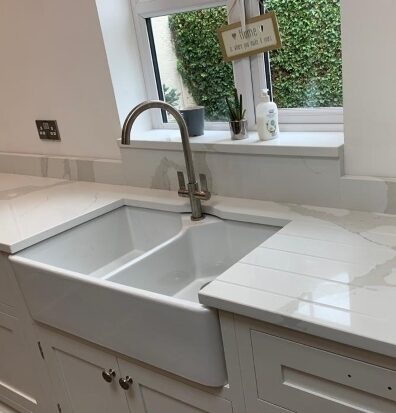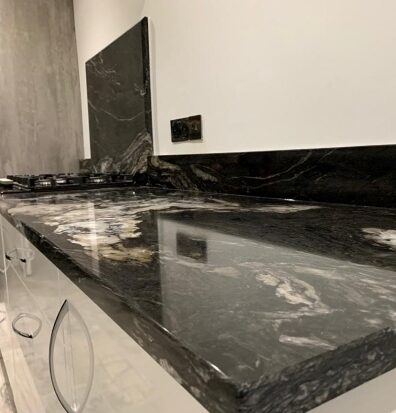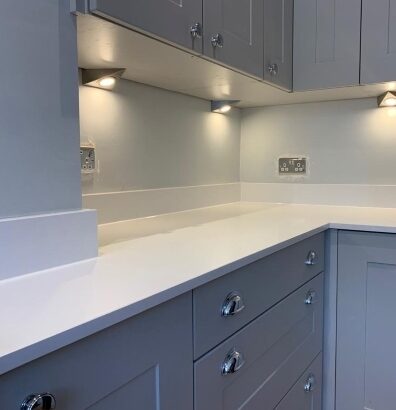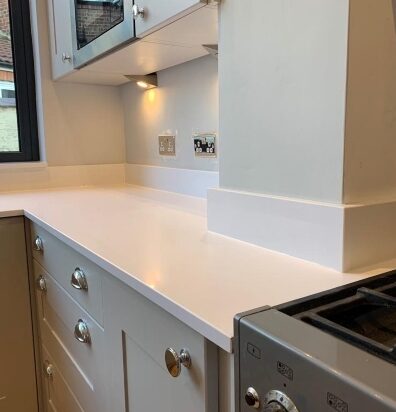Worktop upstands for granite, quartz and ceramic
Worktop upstands are commonly identified as the 10cm high strips of stone that line the back edge of the worktop, glued upright against the wall. They are a superb alternative to tiles, glass splashbacks or anti-stain paints, not only serving a decorative function, but also aid in maintaining a clean and hygienic kitchen environment.
Polish Granite will gladly supply you worktop upstands of any custom height and length. The colour itself is also your choice – you can either pick one from the same stone material as your worktops, or opt for something completely in contrast from the offcut range.
OUR OFFER:
- With any purchased quartz and granite worktop order, our customers will receive a 10% discount on the upstands – no matter the length, height or range of colours
- Our offcut range customers are likewise invited to shop for 10% less
Kitchen worktop upstands out of stone – why upstands for kitchens are worth buying?
The main purpose of worktop upstands to wall is threefold:
- Conceal the wall irregularities: If a wall is very wonky, a worktop itself won’t be able to conceal the forming gaps. A worktop runs in a straight line at the front – the back edge runs in parallel. If a wall at the back is at least a little off, it will be blatant and visible. While tiles might hide some of these irregularities, it might be very expensive to pull off a decent job. Upstands eliminate this problem – stuck on the wall, they line and thus cover the gaps from sight.
- Cheaper solution than tiling: A worktop with upstands is not only a decorative solution – it also fills the functional purpose of tiling. In other words, it acts as protection for the back wall that might collect at the far end of the granite countertop. But instead of opting for a laborious, pricy and frankly unnecessary solution of tiling, you may as well purchase our inexpensive stone strips. They not only beautifully blend in with the stone worktops, but also stop the dirt from piling between the wall and worktop. Worktop upstand to wall are incredibly quick when it comes to installation compared to grouting, and in the end offer a far more satisfying effect than tiles, glass splashbacks or anti-stain wall paint.
- Keeping the kitchen neat and hygienic: Upstands in kitchens prevent all grime, dirt and food particles from ending up in the unnecessary crack between wall and worktop. In essence, it’s an L-shape design that blocks from every remain from touching the wall or falling down the back of the worktop. This allows for quick and easy maintenance of the worktop. You don’t need to painstakingly scrub the back of the worktops as everything is halted where upstands start.




What are worktop upstands?
Kitchen upstands for granite worktops are essentially 10cm tall strips of stone (whether it be granite, ceramic or quartz) that are lined up against the wall at the far end of the worktop.
Their purpose is to conceal the wall irregularities; provide a fitting, additional decor to your walls; and last but not least be a sound replacement for more expensive solutions like tiling, grouting etc.
How high are worktop upstands? And what is the difference between an upstand and splashback
Firstly, an upstand is a thin strip of the same stone as your kitchen worktops. At depth, it measures either 12mm, 20mm or 30mm (that will depend on the thickness of your selected worktops). Height-wise, an upstand can be custom made, suiting whichever height a client demands. However, most kitchen are restricted to about a 15cm max height. Any longer and the upstands start to interfere with the wall-mounted sockets. Therefore the standard dimension of our kitchen upstands is about 10cm.
In some places around the kitchen, we purposely lift the upstands even up to 20cm. For example, if a kitchen worktop sink is located in front of the window, we lift the ribboning 10cm upstand to match the height of the windowsill. Therefore not the quartz upstand and windowsill are nicely joined with the worktop (creating a wondrous cascading/waterfall effect), this design also functions as a mini-splashback for the sink itself.
Why mini-splashback? Well, this nicely guides us to the other question i.e. difference between upstand and splashback.
A kitchen splashback is usually a large piece of stone, glass, metal etc. (a smooth textured material) placed behind a sink or hob purposely to prevent wall damage from water, oils, grease and everyday cooking grime. A splashback differs from tiles, but also the 10cm high, wall-lining upstands – whose primary role is to grant some extra decor.
How thick are quartz upstands?
The thickness, or depth of the kitchen upstands will vary depending on the material you have had chosen for your main work surfaces. So, if you ordered 20mm Calacatta quartz worktops, then it’s likely we’ll use that same material, from the same slabs, to create the kitchen upstands.
So to sum up, the quartz worktop and upstands will be of the same thickness. Which thickness that will be (12mm, 20mm, 30mm) will be entirely dependent on your preference.
Are worktop upstands with tiles worth it?
Frankly this solution is not something we see very often, unless we replace the old worktops with new ones and the original tiles remain in place. Quartz upstands with tiles can be a nice pairing, but if you’re building or renovating your kitchen fresh, from start it might seem like a waste of money.
One of the main reasons upstands are purchased is to fill in the empty space between the wall and the worktops. Whether it be for decorative or functional purposes, like preventing grime from gathering at the far end of the worktop, is irrelevant. The point is that tiles, worktop upstands and splashback all serve that same role. Therefore adopting all methods might be unnecessary and quite redundant – unless, of course, the tiles were originally a part of the kitchen decor.
All in all, however, kitchen worktop upstands and tiles do not clash, but adopting both methods of wall-protection & general decor may be regarded as redundant.
Quartz upstand and splashback solutions are another matter. Tiling doesn’t really work for splashbacks because of the hard-to-clean grouting. A splashback needs to be smooth and as its purpose suggests, easy to maintain to improve the cooking experience. Therefore even if you have tiles, purchasing a splashback above your hob is nonetheless recommended.
Granite worktop upstand or tiles?
If you’re wondering whether to choose quartz upstands or not, we’d highly recommend exploring our GALLERY or Facebook pages to gain some insight into how kitchens with upstands look.
As we mention above, the primary reason people choose upstands is to implement a little more decor into the interior. Because upstands are amazing tools that blend the walls and the worktops together into a contemporary, unified whole.
Since the main function of these stone strips is predominantly decorative, only you can answer the ‘quartz upstands or tiles’ question.
Once again, during such dilemma we strongly recommend upstand ideas pages, our blog posts, people’s reviews and opinions, our Gallery website and Social Media portals, where everything from opinions to pictures are expressed and shared. That way you’ll be able to gain some inspiration.
You’re also welcome to visit our quartz and granite showroom, where we showcase physical samples of stone, even whole worktops that have upstands integrated along the kitchen walls.
How to fit kitchen upstands if I purchase them from offcuts?
A bit of standard, clear silicone will do. That’s the product our fitters use, anyway. Silicone is very strong when dry and it keeps everything in place just fine, without the pieces shifting. As such, there’s no need to implement epoxy glues or anything of that kind.
The clear silicone is used to glue the kitchen upstands to the walls. Meanwhile, to permanently join the upstands with the worktops, we use the silicone to gently brush the miniscule slit between the worktops and upstands.
If you wish for request our professional delivery and installation service, please let us know and we’ll get something organised.
How are quartz upstands fitted during your installation?
Please see the questions above for details. In brief, we put the clear silicone on the back of an upstand and the underside, then simultaneously glue the strip length-wise to the wall and worktop. That method works just fine.
We use a similar method for upstands splashbacks for kitchens.
